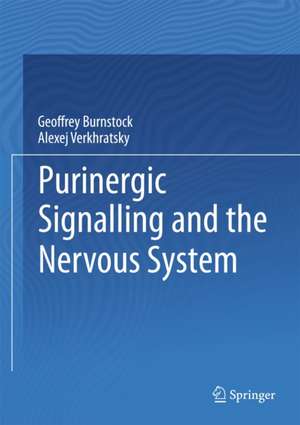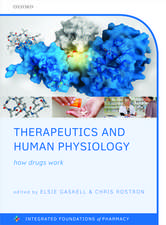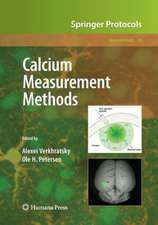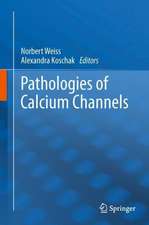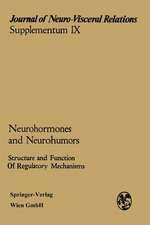Purinergic Signalling and the Nervous System
Autor Geoffrey Burnstock, Verkhratsky Alexeien Limba Engleză Hardback – 6 iun 2012
In two books, Geoffrey Burnstock and Alexej Verkhratsky have aimed at drawing together the massive and diverse body of literature on purinergic signalling. The topic of this first book is purinergic signalling in the peripheral and central nervous systems and in the individual senses. In a second book the authors focus on purinergic signalling in non-excitable cells, including those of the airways, kidney, pancreas, endocrine glands and blood vessels. Diseases related to these systems are also considered.
| Toate formatele și edițiile | Preț | Express |
|---|---|---|
| Paperback (1) | 1357.16 lei 38-44 zile | |
| Springer Berlin, Heidelberg – 22 aug 2016 | 1357.16 lei 38-44 zile | |
| Hardback (1) | 1373.51 lei 38-44 zile | |
| Springer Berlin, Heidelberg – 6 iun 2012 | 1373.51 lei 38-44 zile |
Preț: 1373.51 lei
Preț vechi: 1445.80 lei
-5% Nou
Puncte Express: 2060
Preț estimativ în valută:
262.81€ • 275.14$ • 217.47£
262.81€ • 275.14$ • 217.47£
Carte tipărită la comandă
Livrare economică 01-07 aprilie
Preluare comenzi: 021 569.72.76
Specificații
ISBN-13: 9783642288623
ISBN-10: 3642288626
Pagini: 700
Ilustrații: XVIII, 715 p.
Dimensiuni: 178 x 254 x 45 mm
Greutate: 1.47 kg
Ediția:2012
Editura: Springer Berlin, Heidelberg
Colecția Springer
Locul publicării:Berlin, Heidelberg, Germany
ISBN-10: 3642288626
Pagini: 700
Ilustrații: XVIII, 715 p.
Dimensiuni: 178 x 254 x 45 mm
Greutate: 1.47 kg
Ediția:2012
Editura: Springer Berlin, Heidelberg
Colecția Springer
Locul publicării:Berlin, Heidelberg, Germany
Public țintă
ResearchCuprins
Introduction.- Early history of purinergic signaling.- Purinergic cotransmission.- Mechanisms of ATP release and inactivation.- Receptors for purines and pyrimidines.- Evolution of purinergic signaling.- Peripheral nervous system.- Purinergic signalling in the central nervous system.- Sensory Nerves.- Special senses.- Ontogeny of purinergic neurotransmission.
Textul de pe ultima copertă
In the first 20 years that followed the purinergic signalling hypothesis in 1972, most scientists were sceptical about its validity, largely because ATP was so well established as an intracellular molecule involved in cell biochemistry and it seemed unlikely that such a ubiquitous molecule would act as an extracellular signalling molecule. However, after the receptors for ATP and adenosine were cloned and characterized in the early 1990s and ATP was established as a synaptic transmitter in the brain and sympathetic ganglia, the tide turned. More recently it has become clear that ATP is involved in long-term (trophic) signalling in cell proliferation, differentiation and death, in development and regeneration, as well as in short-term signalling in neurotransmission and secretion. Also, important papers have been published showing the molecular structure of P2X receptors in primitive animals like Amoeba and Schistosoma, as well as green algae. This has led to the recognition of the widespread nature of the purinergic signalling system in most cell types and to a rapid expansion of the field, including studies of the pathophysiology as well as physiology and exploration of the therapeutic potential of purinergic agents.
In two books, Geoffrey Burnstock and Alexej Verkhratsky have aimed at drawing together the massive and diverse body of literature on purinergic signalling. The topic of this first book is purinergic signalling in the peripheral and central nervous systems and in the individual senses. In a second book the authors focus on purinergic signalling in non-excitable cells, including those of the airways, kidney, pancreas, endocrine glands and blood vessels. Diseases related to these systems are also considered.
In two books, Geoffrey Burnstock and Alexej Verkhratsky have aimed at drawing together the massive and diverse body of literature on purinergic signalling. The topic of this first book is purinergic signalling in the peripheral and central nervous systems and in the individual senses. In a second book the authors focus on purinergic signalling in non-excitable cells, including those of the airways, kidney, pancreas, endocrine glands and blood vessels. Diseases related to these systems are also considered.
Caracteristici
The first comprehensive overview of the purinergic signaling system
This edition (vol. 1) focuses on purinergic transmission in both the peripheral and central nervous systems
Companion volume (vol. 2) will focus on purinergic signaling in all non-neuronal tissues
Includes supplementary material: sn.pub/extras
This edition (vol. 1) focuses on purinergic transmission in both the peripheral and central nervous systems
Companion volume (vol. 2) will focus on purinergic signaling in all non-neuronal tissues
Includes supplementary material: sn.pub/extras
